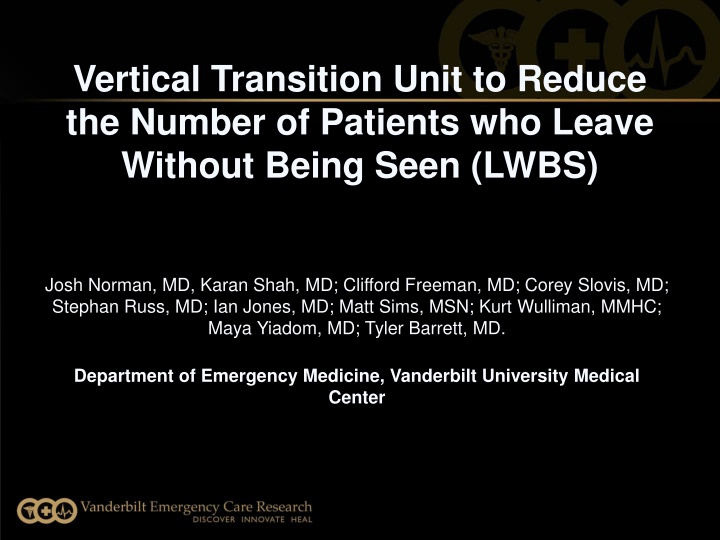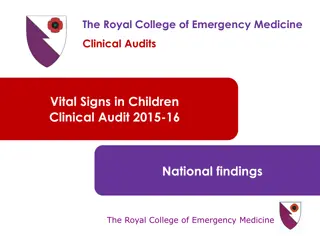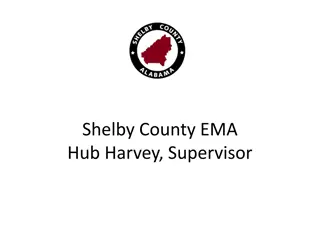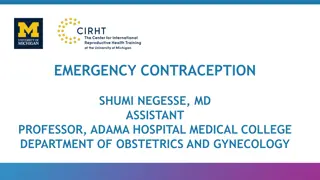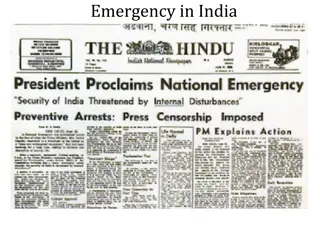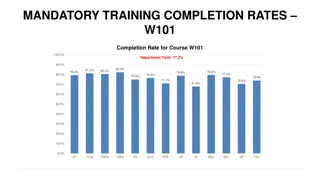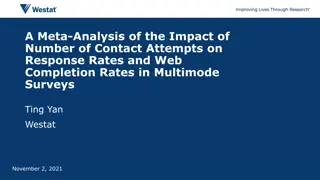Strategies for Reducing LWBS Rates in Emergency Departments
In this study conducted at Vanderbilt University Medical Center, a Vertical Transition Unit (VTU) was implemented to address the issue of patients leaving without being seen (LWBS) in the emergency department. The VTU aimed to reduce LWBS rates and overall ED length of stay by targeting mid to low acuity patients for likely discharge. While the primary outcomes did not show a significant change during the pilot period, the VTU approach may have potential benefits in optimizing patient flow and reducing LWBS rates in the long term.
Download Presentation

Please find below an Image/Link to download the presentation.
The content on the website is provided AS IS for your information and personal use only. It may not be sold, licensed, or shared on other websites without obtaining consent from the author.If you encounter any issues during the download, it is possible that the publisher has removed the file from their server.
You are allowed to download the files provided on this website for personal or commercial use, subject to the condition that they are used lawfully. All files are the property of their respective owners.
The content on the website is provided AS IS for your information and personal use only. It may not be sold, licensed, or shared on other websites without obtaining consent from the author.
E N D
Presentation Transcript
Vertical Transition Unit to Reduce the Number of Patients who Leave Without Being Seen (LWBS) Josh Norman, MD, Karan Shah, MD; Clifford Freeman, MD; Corey Slovis, MD; Stephan Russ, MD; Ian Jones, MD; Matt Sims, MSN; Kurt Wulliman, MMHC; Maya Yiadom, MD; Tyler Barrett, MD. Department of Emergency Medicine, Vanderbilt University Medical Center
Background In 2017 VUMC ED had 4.7% patients leave without being seen (LWBS) Negative impact on patient safety as well as departmental and hospital revenue In our experience high acuity patients were likely to be admitted, while lower acuity patients (ESI 3-5) waited due to not being sick or requiring additional ED workup
Hypothesis Vertical transition unit (VTU) unit designed to select mid to low acuity waiting room patients that met criteria for likely discharge would decompress the Emergency Department and reduce LWBS rate and overall EDLOS.
Metrics Primary outcomes: reduce left without being seen rate (LWBS) difference in overall EDLOS Secondary outcomes: to reduce the individual sub-cycles of care that together comprise ED length of stay (LOS) for VTU patients.
Methodology VTU was designed and piloted for 3 months (Monday-Thursday 1 pm- 9pm) VTU composed of 5 chair spaces Dedicated resident, nurse, paramedic, and rotating assigned attending physicians Patients were selected from waiting room using VTU Eligibility Process and Flow Protocol
VTU Eligibility and Process Flow Protocol
Data Analysis We considered the use of medians, but given that we were interested in the influence of outliers in what should be a consistent rapid-turnover unit, we opted to use means.
Results Primary Outcomes Comparing Before and During the Pilot LWBS rates 4.65% vs 4.89% were not significantly changed Mean ED LOS 4.82 hours vs 4.67 hours were not significantly different
Results Secondary Outcomes VTUs ability to decompress the waiting room was compared to our Fast Track (Table 2). More patients were seen in the VTU Patient acuity was about the same in the VTU and FT (mean ESI 3.47 vs 3.33). VTU LOS (2.7 hours vs 4 hours) was lower.
Results In addition, sub-cycle components of EDLOS for VTU patients times were lower: Work-up time was 1.7 hours vs 2.7 hours, and Disposition-to-discharge time was 0.3 versus 0.5 hours.
Conclusions The VTU model, improved ED throughput for mid and low acuity patients, and outperformed our Fast Track area despite seeing more patient volume
Conclusions These results demonstrate gains in efficiency, however, the VTU did not reduce overall ED LOS or LWBS rates. A larger sample size and unit trial period may be needed to observe a translation of efficiency into reduce the ED s LWBS.
